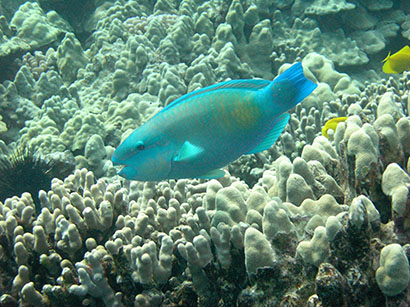- ABOUT US
- PROGRAM AREAS
- CONSERVATION APPROACH
- EDUCATION
- MULTIMEDIA
Science to Support Marine Resource Management in Maui

Photo credit: R. Sparks, Hawaii Division of Aquatic Resources
New parrotfish and goatfish management rules in Maui seek to strike a balance between commercial fishing and conservation.
Recent fishing rules signed by Hawaii's governor highlight how important solid science is to effective ecosystem-based management practices. The rules cap the number of parrotfish and goatfish caught in Maui's waters.
They include a limit of no more than two parrotfish per person per day and prohibit the "take" of certain species of large male parrotfish. There are also limits to the number of certain goatfish species that can be harvested per day.
Science and Community Driven Management
The management decision was supported by over a decade of fish survey data. Marine resource managers in Maui combined years of their own fish monitoring data with a larger body of statewide data collected by NOAA researchers to get a better idea of the status of these important coral reef species around Maui.
What they found was that large parrotfish, particularly male parrotfish, were mostly absent from shallow reefs where they play a key role in maintaining a balanced ecosystem. These fish species actively graze the reef, controlling algae and creating suitable habitat for new coral recruits to establish themselves and begin to grow.
These findings echoed what many in the fishing community already knew. Members of Maui's fishing community actively engaged in management discussions and public meetings about a potential bag rule from the earliest stages. Their concerns, together with strong scientific support, ultimately helped drive the overall development of the rules.
Striking a Balance
The goal of the management decisions is not to hurt or eliminate commercial fishing but to conserve important species for subsistence take first, while allowing commercial harvest that conforms to the bag limits.
Managers hope these rules will curb the overharvest of large parrotfish and goatfish and ultimately improve the condition of Maui's shallow-water coral reef ecosystems.
Partners for this effort:
Hawaii Division of Aquatic Resources, NOAA Coral Reef Conservation Program and NOAA Coral Reef Ecosystem Division, Pacific Islands Regional Office, and others.
For more information, visit www.dlnr.hawaii.gov.
About Us

The NOAA Coral Reef Conservation Program was established in 2000 by the Coral Reef Conservation Act. Headquartered in Silver Spring, Maryland, the program is part of NOAA's Office for Coastal Management.

The Coral Reef Information System (CoRIS) is the program's information portal that provides access to NOAA coral reef data and products.
Work With US
U.S. Coral Reef Task Force
Funding Opportunities
Employment
Fellowship Program
Contracting Assistance
Graphic Identifier
Featured Stories Archive

Access the archive of featured stories here...
Feedback
Thank you for visiting NOAA’s Coral Reef Conservation Program online. Please take our website satisfaction survey. We welcome your ideas, comments, and feedback. Questions? Email coralreef@noaa.gov.
Stay Connected
Contact Us
NOAA’s Coral Reef Conservation Program
SSMC4, 10th Floor
1305 East West Highway
Silver Spring, MD 20910
coralreef@noaa.gov
